Top leading building information modeling companies
Understanding building information modeling and its impact
Building information modeling (BIM) is a massive paradigm shift for the architecture, engineering, and construction industry which moves it beyond regular CAD drawings to create intelligent and data-rich three-dimensional models. BIM is more than just software or technology – it is a collaborative approach capable of transforming the way buildings and infrastructure are designed, constructed, and operated.
The overall impact of BIM on the construction industry has been not only profound but also multifaceted. From a design perspective, BIM offers complex and innovative architectural forms while boosting capabilities for coordination between disciplines. A single unified model means that structural, mechanical, electrical, and plumbing systems can be integrated into it and analyzed afterwards to detect potential conflicts early on.
For contractors and construction managers, BIM can provide impressive visibility into the entire building process. The utility of a BIM model can be extended beyond spatial representation with the help of detailed scheduling, cost estimation, and sustainability analysis. Additionally, a significant reduction in waste, rework, and scheduling delays can be achieved via construction sequence simulation, material quantity calculation, work package optimization, and plenty of other advantages.
Improved handover documentation and operational support are also beneficial in their own way, especially for building owners and facility managers. The as-built model serves as a comprehensive database for all building information, helping streamline maintenance activities and space management throughout the entire lifespan of the facility. This data continuity is widely considered to be one of the biggest advantages of BIM.
As BIM continues to evolve, many emerging technologies such as artificial intelligence (AI), machine learning (ML), and digital twins will keep expanding its capabilities in different ways. Further transformation of the built environment may be possible using predictive analytics, automated design optimization, and real-time performance monitoring. The future of BIM is not just about improvements to design and construction, but also about creating smarter buildings capable of adapting to environmental conditions or human needs.
BIM companies and BIM solution providers: what is the difference?
The BIM ecosystem includes a wide range of businesses that can be broadly categorized as BIM companies and BIM solution providers. The distinction between the two is not crystal clear, and knowing the attributes of each category is important for properly navigating the complex landscape of BIM implementation.
BIM companies are businesses on the AEC market that manage to integrate BIM methodologies into their own professional practice. These organizations use BIM processes to deliver various construction-oriented services to their clients, with their core business being all about creating, manipulating, and applying BIM models to real-world projects rather than developing BIM software itself.
BIM solution providers, on the other hand, are all about developing and marketing various tools, technologies, and software platforms that enable BIM implementation. Their primary focus is in developing the digital infrastructure that powers the BIM process throughout the industry, and the biggest share of their revenue comes from subscriptions, software licenses, training, and support services. All leading BIM solution providers compete on the same market to offer the most versatile, efficient, and user-friendly BIM solution.
The relationship between these groups is inherently symbiotic, with BIM solution providers relying heavily on the feedback from BIM companies to refine their tools and services. BIM companies, similarly, depend on solution providers to deliver robust, reliable platforms capable of supporting their professional work while helping them stay competitive in an increasingly digital construction industry.
It would also be fair to say that the boundaries between these two groups have become increasingly blurry in recent years, with many large AEC companies developing proprietary BIM tools, plugins, or workflows to enhance specific features, which essentially makes them hybrid entities of sorts that both use and create BIM solutions. Some BIM software companies have also expanded into offering professional services in the field, such as BIM consulting, training, implementation support, etc.
A proper understanding of these distinctions should help stakeholders identify appropriate partners and resources for their BIM needs. It is important to consider both the BIM capabilities of internal design and construction teams, as well as the capabilities of the software platforms that will be used for the creation, modification, and sharing of building information models. Effective BIM implementation requires proper alignment between organizational expertise and technological tools in order to apply both in an effective manner throughout the project lifecycle.
BIM companies shaping the construction industry
Now that we are aware of what a BIM company is, we can present a number of prominent examples in the field.
1. Gensler
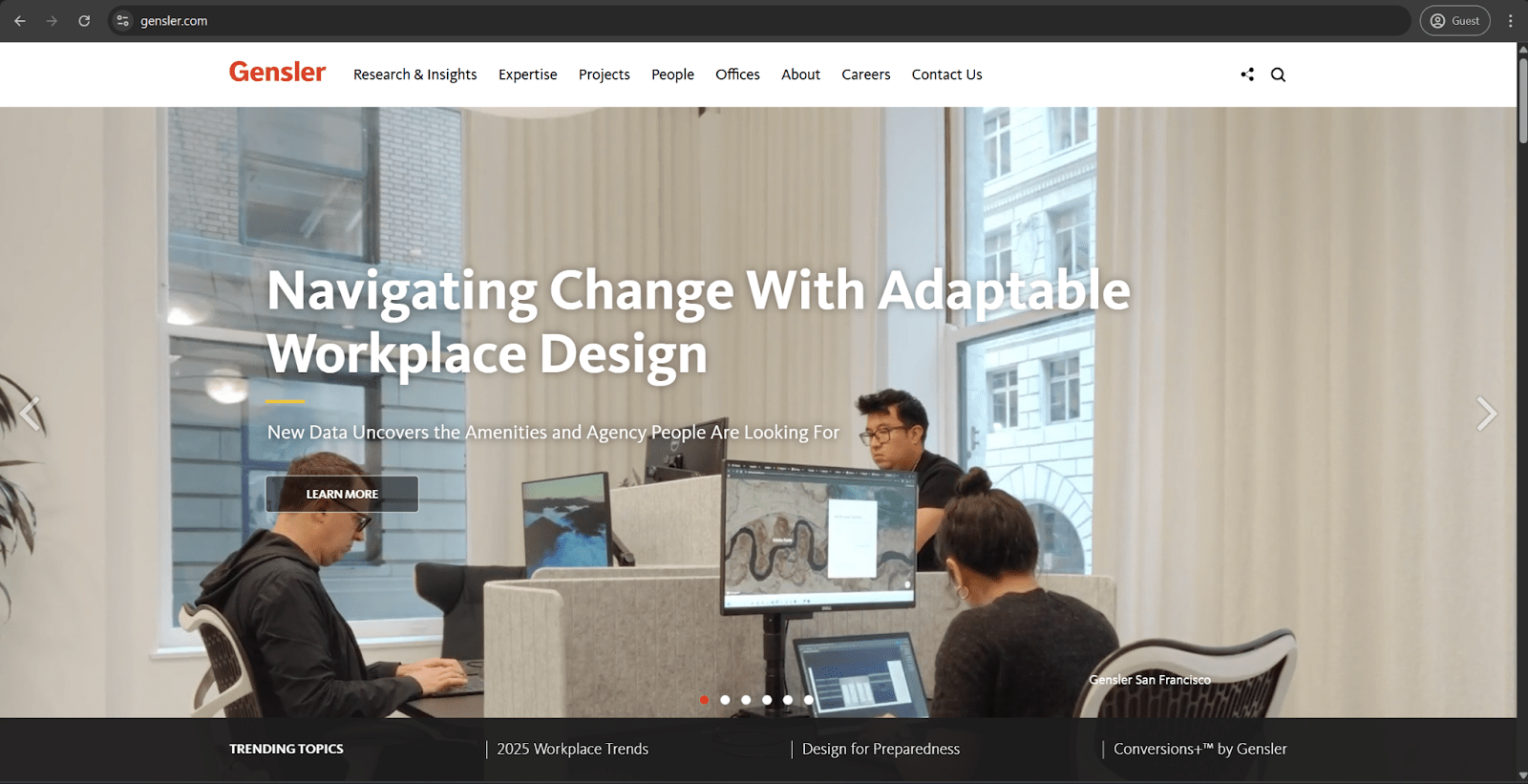
Founded in 1965 and headquartered in San Francisco, Gensler has evolved into a massive architecture and design business with over 6,000 professionals across 57 offices worldwide. They approach building information modeling with an emphasis on centralized model coordination, driving innovation in design and construction efficiency at the same time.
Shanghai Tower is the flagship BIM implementation project for Gensler, a 632-meter skyscraper that showcased advanced BIM coordination between dozens of consulting companies from mechanical engineering, architectural structure, and many other industries. It is reported that the use of 3D BIM models saved the company around 32% on construction costs compared with traditional 2D projects.
Gensler continues to demonstrate its commitment to BIM innovation in projects such as Shanghai’s One Museum Place, where a LEED Platinum certified tower was delivered through integrated design approaches despite its complexity and time constraints. The project also introduced a state-of-the-art air filtration system that provides impressively clean air by local standards. It is one of many examples of how Gensler leverages BIM technology to optimize both occupant well-being and environmental performance in its projects.
2. Perkins + Will
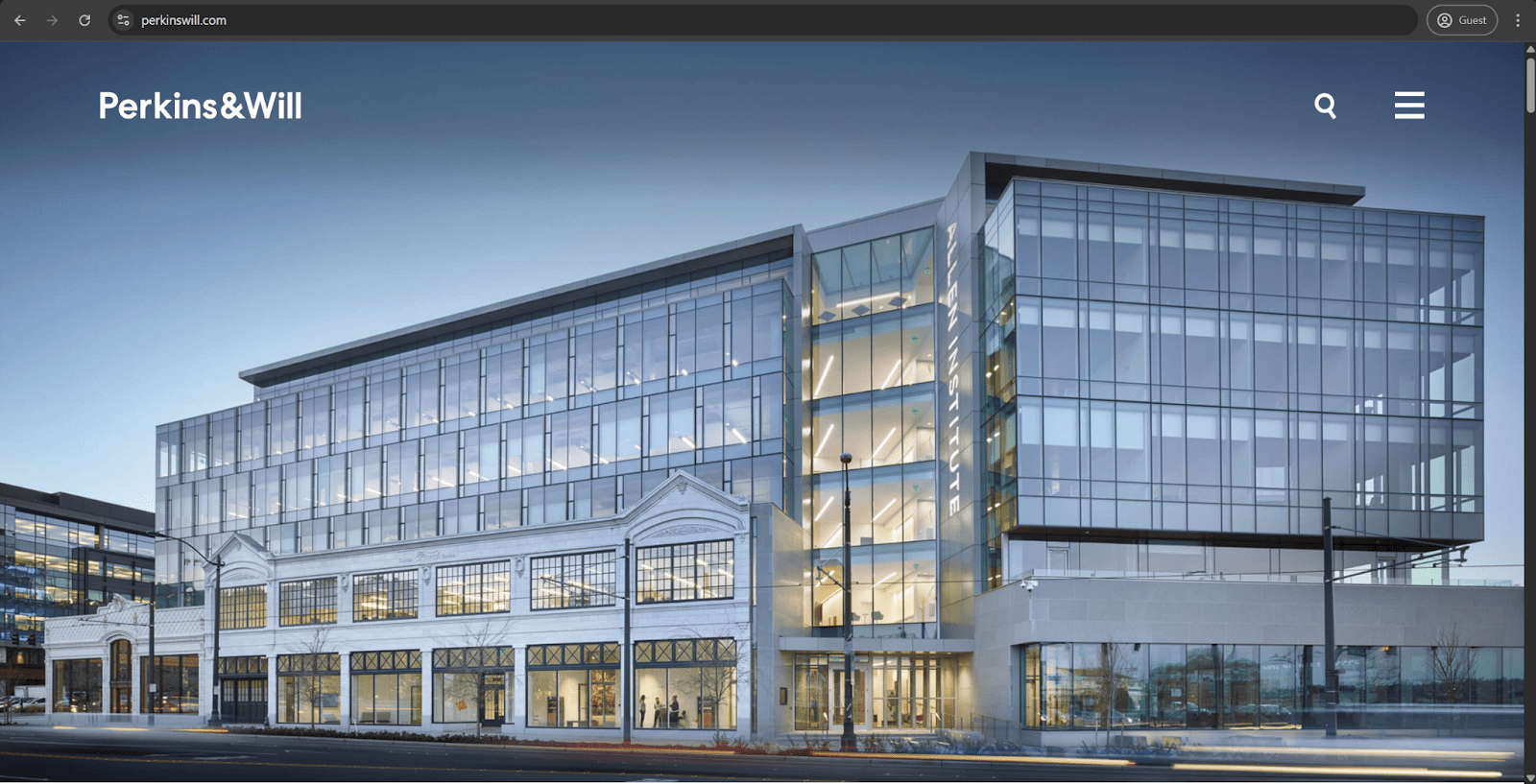
Founded in 1935 by Lawrence Perkins and Philip Will Jr., Perkins+Will has become a global design powerhouse with a commitment to sustainable architecture. The company currently operates as a subsidiary of Dar Al-Handasah with offices all over the planet and thousands of design professionals dedicated to creating high-performance buildings with cutting-edge technology and environmental responsibility.
Perkins+Will’s approach to BIM implementation puts a substantial emphasis on digital innovation throughout the entire design and delivery sequence. The company’s transdisciplinary team goes above and beyond the basic application of BIM via the integration of advanced digital solutions throughout the architectural workflow. They also utilize an extensive internal database of all their successful projects to develop machine learning applications capable of “automating a lot of the initial documentation” while design work continues in parallel.
Notable BIM-driven projects of the company include award-winning sustainable designs like the University of Washington Life Sciences Building (featuring innovative solar fins), as well as the 1 De Haro cross-laminated timber structure in San Francisco. Perkins+Will continuously explores new technologies and methodologies using its Innovation Incubator program, offering “micro-grants of money and time” to staff members with the goal of developing ideas that could “improve design work, open new business areas, and stretch collective creativity”. This commitment to research-informed practice has established the company as a leader in sustainable architecture with more LEED-accredited professionals than any other design business in North America.
3. HOK
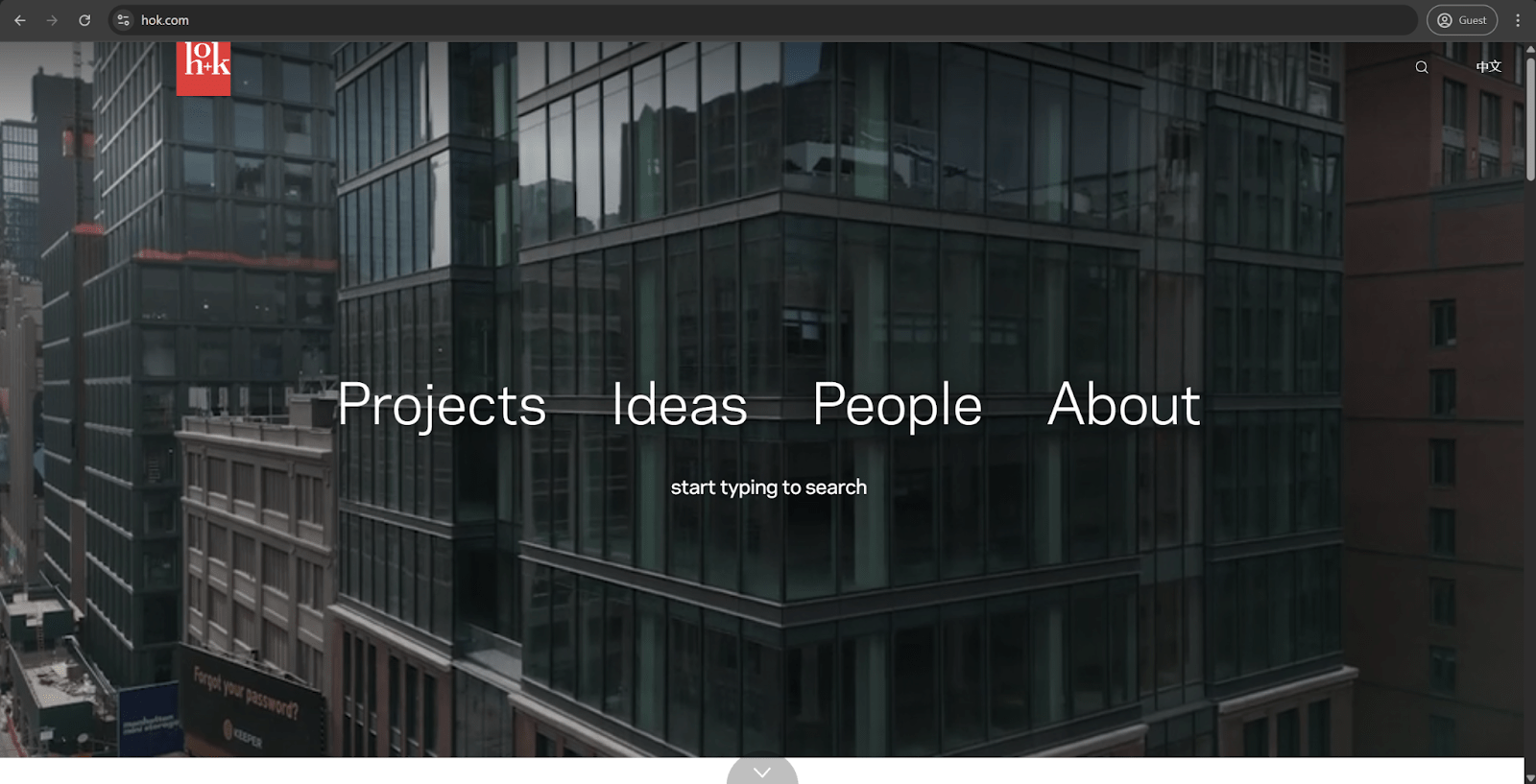
Founded in 1955 by George Hellmuth, Gyo Obata, and George Kassabaum in St. Louis, HOK has successfully evolved into a global powerhouse of design, architecture, engineering, and planning. The company has 26 offices all across North America, Europe, and Asia and collaborates on projects that put emphasis on innovation, sustainability, and human-centered design in a diverse selection of sectors, from healthcare and sports to aviation and corporate environments.
HOK’s involvement with building information modeling goes back to the early 2000s, using its own HOK Draw CAD solution from 1983 as the baseline. Its journey with BIM implementation evolved from early explorations with Autodesk Architectural Desktop to the comprehensive adoption of Revit after substantial research, pilot projects, and global user workshops as the means of gathering feedback. HOK’s director of design technology innovation, Greg Schleusner, actively participates in buildingSMART’s Strategic Advisory Council, working toward improving IFC implementation and interoperability standards for the entire industry.
The company’s BIM expertise is showcased in award-winning projects such as King Abdullah University of Science and Technology in Saudi Arabia, which was the largest LEED Platinum project in the world. Mark Cichy, HOK’s Senior Associate and Director of Design Technology, notes that one of the biggest breakthroughs has been “the ability to interoperate and collaborate across multiple disciplines and platforms in near real-time”. HOK has formalized its approach with a “buildingSMART” framework, using project execution plans that define not only the objectives of BIM but also technologies and workflows for each project, creating clear expectations and quality outcomes from any design and construction workflow.
4. Zaha Hadid Architects

Founded by Dame Zaha Hadid (1950-2016), this visionary practice has quickly become a synonym of fluid, parametric architecture that challenges traditional building forms. Nowadays, it operates with over 400 staff members from 55 nations in 44 countries, creating transformative spaces across all sectors and scales, from cultural institutions to residential towers, with almost a thousand projects in its portfolio from all around the world.
ZHA’s approach to BIM implementation is tailored to accommodate its signature fluid architecture. The company’s computational workflows require custom solutions capable of transforming complex parametric designs into BIM models and the establishment of dedicated internal teams to manage this process, with the biggest example being the Computation and Design research group (ZHCODE), which was founded in 2007 by Nils Fischer, Shajay Bhooshan, and Patrik Schumacher in order to spearhead architectural experimentation.
Harry Ibbs, Head of BIM at ZHA, claims that “BIM is part of the whole design process, not coming after the project”. This reflects the company’s holistic approach to BIM integration in order to facilitate better and faster workflows. This integration is most obvious in projects like Fornebu station in Oslo, with ZHA transforming its internal coordination process by implementing BIMcollab Nexus for real-time collaboration purposes, enhancing accountability while enabling “faster solving and more coordinated design solutions”. ZHA has managed to establish itself as a pioneer in merging computational design with practical construction documentation using its own innovative method of adapting non-standard geometries into BIM environments.
5. Arup
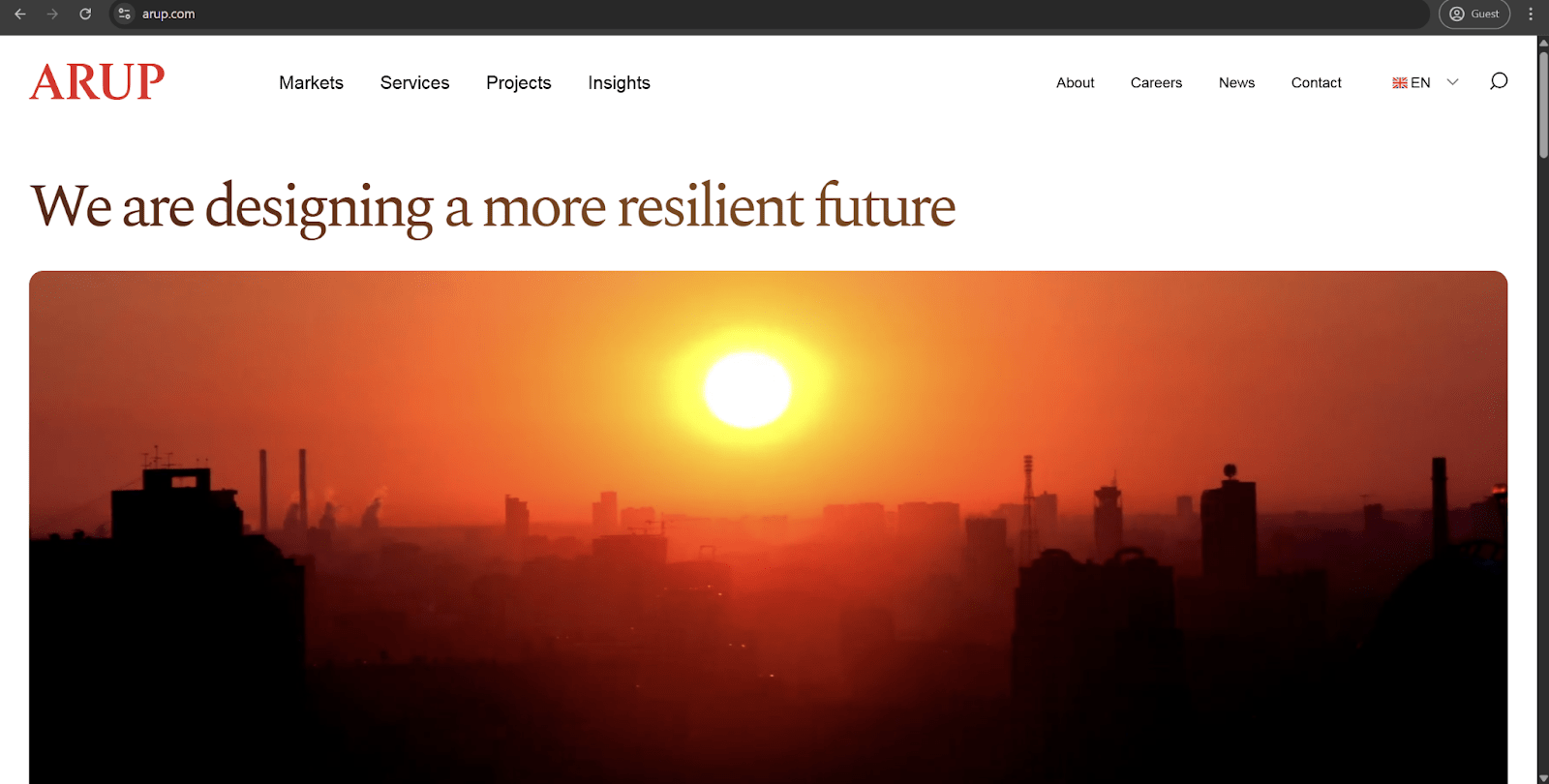
Founded in 1946, Arup quickly grew into a global engineering and design consultancy with 16,000 professionals in over 140 countries. It offers multidisciplinary services for the built environment, from structural and civil engineering to sustainability consulting, digital services, and innovative technology solutions. It collaborates with clients on projects ranging from urban planning and environmental initiatives to critical infrastructure projects and iconic buildings.
Arup has been a pioneer of BIM implementation for a while now, establishing itself as a leader in developing ISO standard BIM execution plans. Its internal approach extends beyond basic modeling to “enable automated geometry and design, layout and documentation of repeat elements and provide coordination across disciplines“, forming one singular source of truth for all stakeholders in the project. It also actively contributes to the development of industry standardization via its involvement with buildingSMART, promoting the proper alignment of protocols and naming conventions that are important for the digital integration process.
In 2014, Arup developed the BIM Maturity Measure (BIM-MM). It is an assessment tool designed to evaluate BIM implementation across multiple projects, tested on 213 different projects beforehand to learn how to offer valuable insights while measuring implementation maturity across various metrics. The tool is also freely available to the industry. It is Arup’s attempt to demystify BIM to a certain degree while helping drive awareness of what best practices in BIM look like. Its BIM models can serve as foundations for various analytical applications, such as carbon emissions calculations, energy use assessments, fire safety analysis, and other ways to demonstrate how integrated digital tools can enhance project outcomes throughout the entire project lifecycle.
6. Skanska
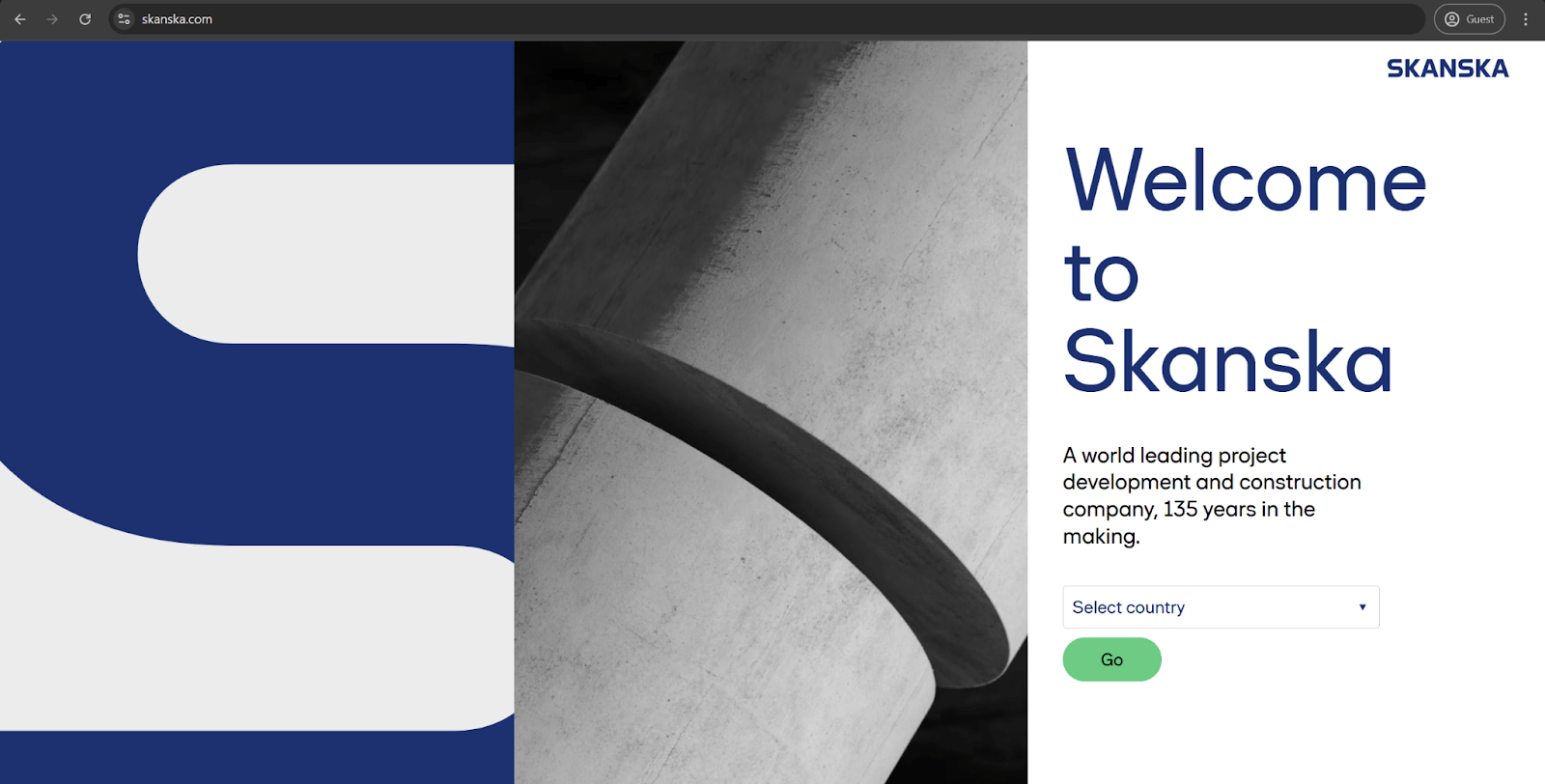
Founded in 1887 in Sweden, Skanska has grown into one of the biggest construction and development groups on the planet, operating in Europe and the United States with a strong focus on sustainable building practices. The company employs around 30,000 professionals worldwide, specializing in not only building construction, but also civil infrastructure, residential and commercial development, and public-private partnerships with the stated purpose of “building for a better society.”
At this point, Skanska has strategically integrated building information modeling throughout its global operations. The emergence of BIM and related technologies serves as a strong transformational force in the design and construction industry, which is why “VDC has been implemented during every phase of the project life cycle, from conceptual design through facility management”. The company has applied BIM in many different types of project, such as buildings, roads, bridges, tunnels, and even industrial plants. The results of this widespread integration are: improved communication among project stakeholders, enhanced project efficiency, and massive risk reduction across the board, as well as a higher degree of certainty in both cost and schedule estimation.
As a testament to its leadership in the industry, Skanska was one of the first contractors to receive the highest possible level of BIM certification, the BSI BIM Kitemark™. David Throssell, Head of Digital Construction of Skanska UK, claims that the primary challenge in BIM implementation is no longer technology but “people and cultural change”. Skanska Sweden has even set ambitious targets through its digital transformation initiatives, including its Digital Construction Platform, which was built on “Autodesk BIM 360 and Autodesk Forge” to help teams review all previous 2D drawings, 3D models, and documents from any device. Skanska aims to use these innovations to reduce construction costs, cut construction time, and improve overall sustainability performance to demonstrate how BIM and digital engineering are paramount to its future vision.
7. A-lab
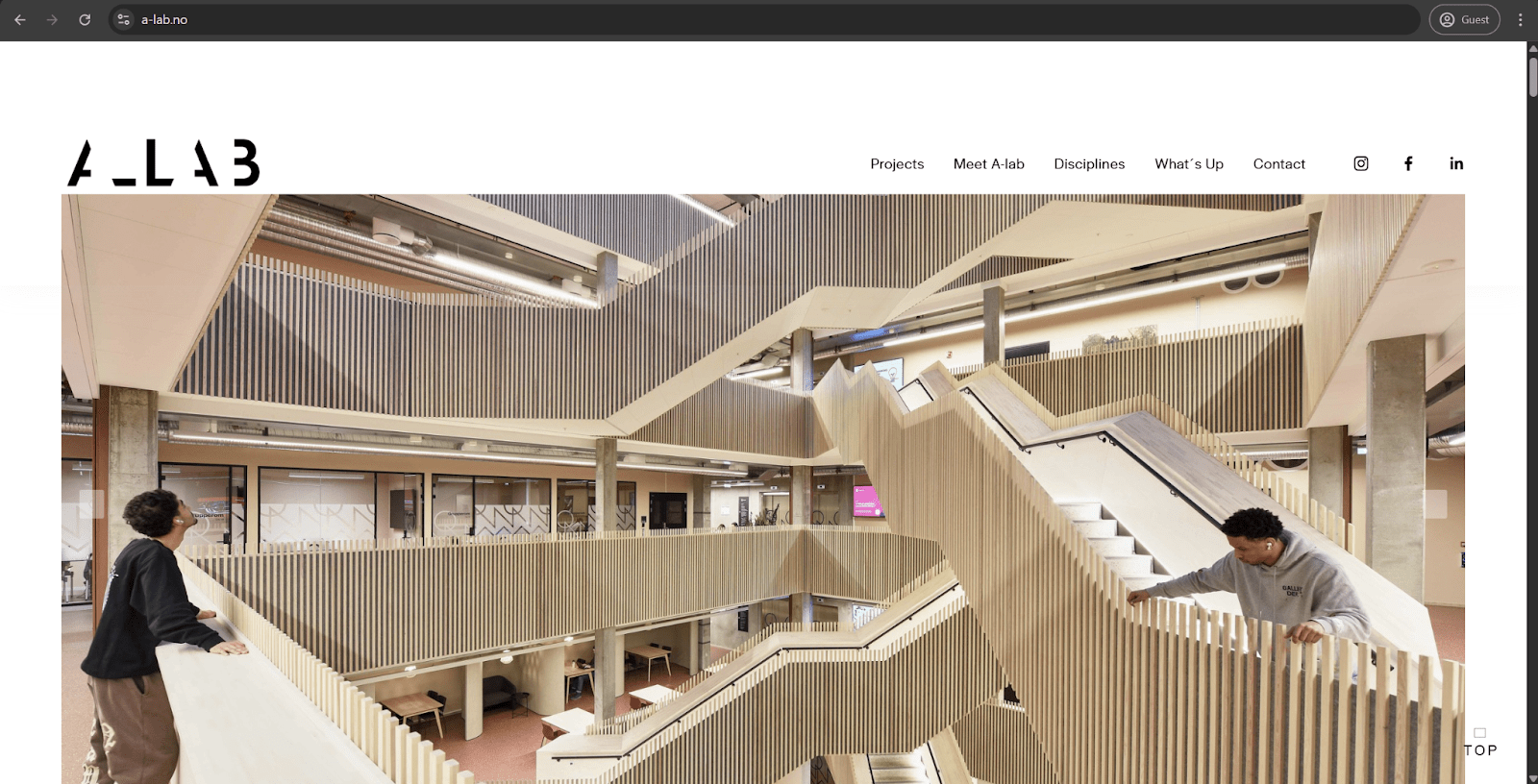
Founded in 2000 by Geir Haaversen and Odd Klev, A-lab has grown into a prominent architectural business and one of the best companies in the field on Norway’s market. Its main office is in Oslo, and it has also established international branches in France, Denmark, and Portugal. The company employs over 120 professionals: architects, interior designers, urban planners, technology specialists, landscape architects, social scientists, and other experts that collaborate in order to create innovative buildings and environments with a strong focus on identity and sustainability.
A-lab is known as an expert in interdisciplinary BIM design, using advanced digital tools throughout its workflow to work with complex projects in an efficient manner. Its expertise covers a variety of domains, from design architecture to urban planning, and the company is “often used as a reference in sustainable urban and local development, iconic architecture and interdisciplinary BIM design”. The portfolio of A-lab includes many different project types, including comprehensive urban master plans, housing developments, office buildings, and cultural centers.
One of A-lab’s most celebrated BIM implementations is the Statoil headquarters project in Fornebu, Norway. It is a unique structure consisting of five stacked blocks or ‘lamellas’ measuring 140 meters in length and 23 meters in width, with BIM being used to coordinate complex design and construction process, making it possible to complete within a very tight timeframe of 20 months. It is a “hashtag-shaped building that looks like a game of Mikado from afar”, showcasing how BIM technologies help architects realize the most unconventional design ideas without sacrificing usability and other important factors. Other important projects of the company include its substantial contribution to the Barcode masterplan in Oslo, as well as its collaboration with Zaha Hadid Architects on the Fornebubanen Metro Line Stations.
8. UNStudio

Founded in 1988 by Ben van Berkel and Caroline Bos, UNStudio – United Network Studio – is a modern global architectural practice with offices in Amsterdam, Dubai, Melbourne, Hong Kong, Frankfurt, and Shanghai. It employs approximately 250 professionals across 27 countries, forming a collaborative environment with a strong emphasis on research, innovation, and multidisciplinary design approaches for various projects.
UNStudio’s approach to BIM implementation is all about integrating advanced digital technologies throughout the design process. Its project portfolio covers practically every aspect of architecture, ranging from small to large-scale projects, research, and theory in a multidisciplinary environment that values technological innovation. Ami Nigam, Architect and Design Technology Specialist at UNStudio, claims that the company’s workflows successfully combine BIM documentation with computational design. This integration allows the company to manage extremely complex geometries and data-driven design solutions in different projects.
The company’s specialized BIM team handles sophisticated projects using custom workflows, bridging conceptual design tools and documentation platforms. According to the same interview with Ami Nigam from above, UNStudio’s approach includes “developing computationally driven facade systems, running optimization algorithms”, and even creating workflows that can transfer complex geometries from Rhino to Revit and vice versa. Notable projects that showcase the digital expertise of UNStudio include the award-winning Green Spine towers in Melbourne’s Southbank Precinct, the Möbius House, with its single-surface concept, and various collaborative infrastructure projects such as the Austin Light Rail in Texas. The company maintains its distinctively fluid architectural language with constructability and project delivery by emphasizing the combination of structured BIM implementation and parametric design capabilities.
9. Samoo Architects & Engineers
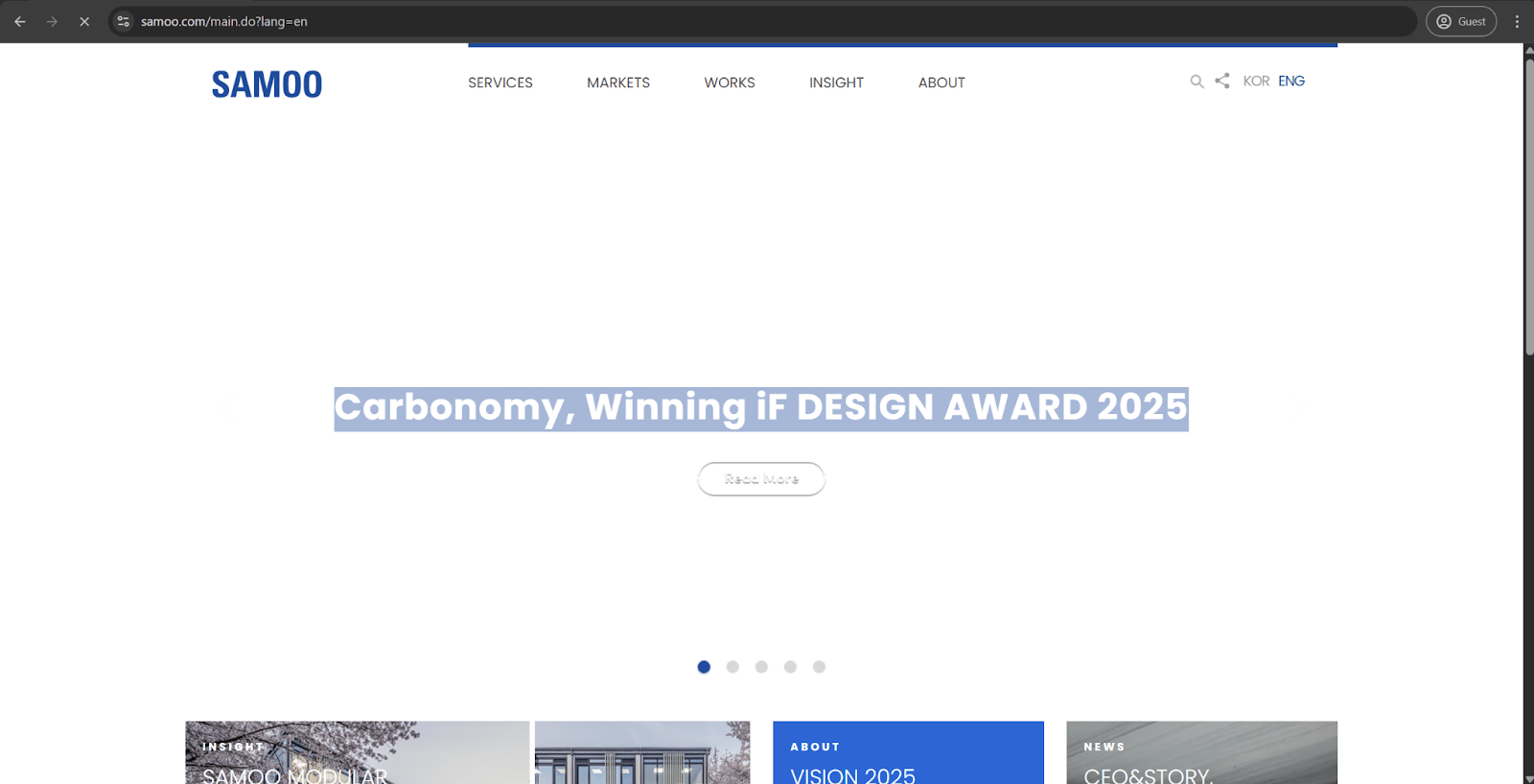
Founded in 1976 as SAMOO Design Lab, Samoo Architects & Engineers has grown into a massive architectural business with headquarters in Seoul, South Korea and five global offices. Now rebranded as SAMOOCM, the company employs over a thousand professionals and provides a wide range of comprehensive services in architectural design, urban planning, interior design, engineering, and much more. SAMOO’s portfolio includes a variety of projects in the healthcare, residential, industrial, cultural, office, and many other sectors.
It has established itself as a pioneer in BIM implementation in South Korea. The company offers its BIM services for all phases of the project, based on “rich experience utilizing BIM and 4D+5D simulation techniques introduced for the first time in Korea”. Expertise is recognized via the annual SAMOO Design Awards, where impressive projects are honored in several categories, including BIM and Advanced Technology, both of which demonstrate the company’s commitment to technical innovation and design excellence.
One of SAMOO’s most noteworthy BIM implementations is part of the National Library of Sejong City project. A substantial number of structural elements, including slabs, columns, and cores, were modeled using BIM in order to confirm their viability and constructability for an iconic building designed with “the motif of a book page being turned over”. BIM technology was integrated from the start of the project due to its unique geometry, offering solutions to various pre-construction simulations of interoperability among different disciplines. The company has also achieved Level 1 certification for “both Building Energy Efficiency and Barrier-Free (BF) Environment by the persistent utilization of 3D BIM systems for safety management” to demonstrate its commitment to sustainable design using digital technologies.
10. Morphogenesis
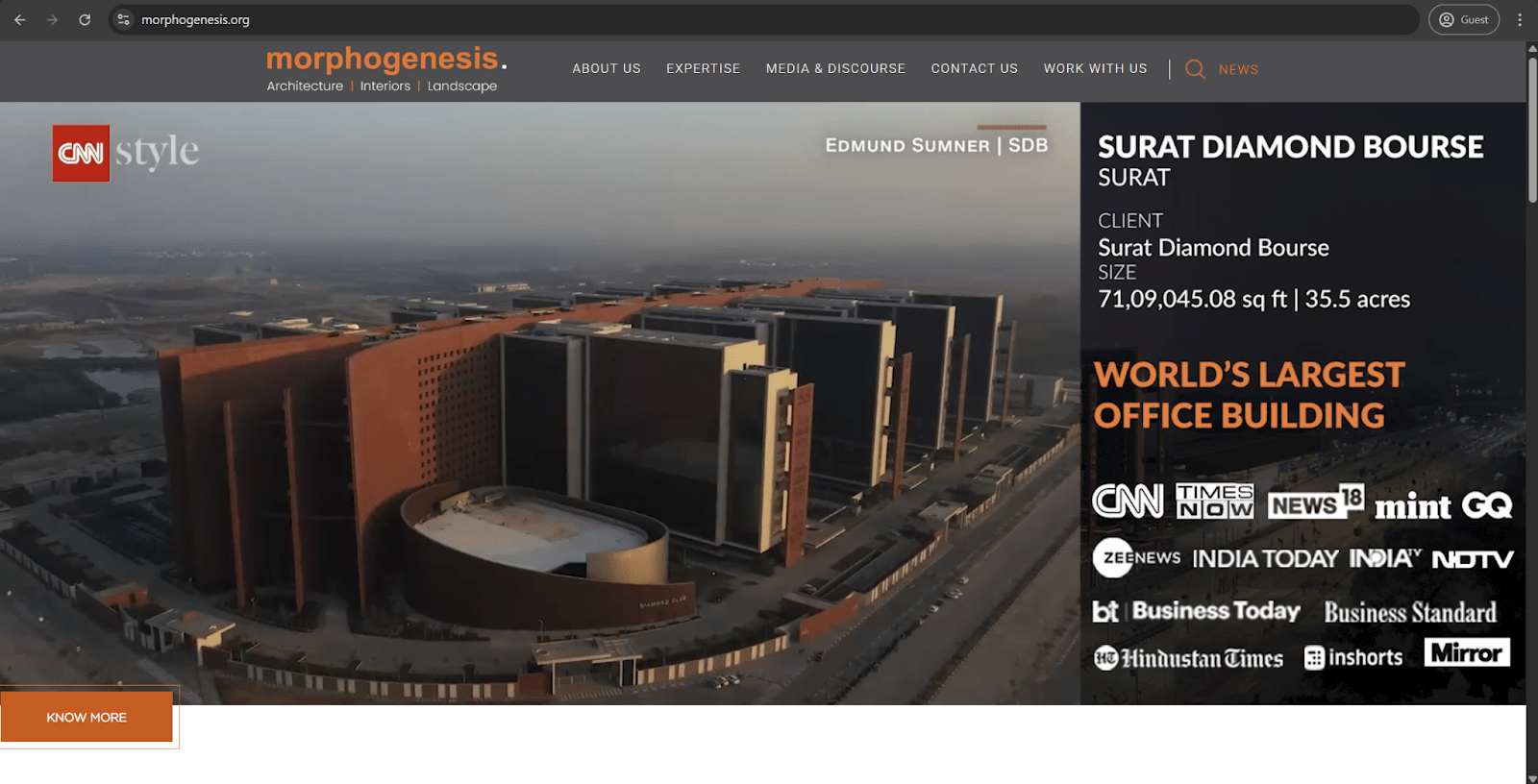
Founded in 1996 by Sonali and Manit Rastogi, Morphogenesis has grown to become one of the most prominent and award-winning architecture and urban design practices in India. It has offices in Mumbai, Bengaluru, and New Delhi, and it uses a multidisciplinary approach to project delivery across many different sectors, from residential to institutional and commercial. It also operates both in India and internationally in countries such as Bangladesh, Nepal, Sri Lanka, South Africa, and the UAE.
The company is guided by its copyrighted design philosophy, called “SOUL” (Sustainability, Optimization, Uniqueness, and Liveability), which forms the foundation of all its projects. Its approach to sustainability is the very basis of its design philosophy, with projects consuming significantly less energy through passive design and the creation of microclimates. A strong focus on sustainable design has positioned Morphogenesis as a leader in net-zero energy and sustainable design, blending a contemporary Indian perspective with a global approach to building creation.
Although Morphogenesis used to rely on conventional CAD tools, it has increasingly embraced BIM technology in recent years. The company “began implementing BIM in order to reduce [its] dependence on CAD for complicated projects”, finding that Revit software greatly improved its ability to handle large-scale and diverse projects in the field. Morphogenesis is now recognized as one of the few businesses in India leading BIM implementation, demonstrating how digital tools can help with its sustainability-focused approach. Notable projects showcasing its passive design strategies include the Pearl Academy in Jaipur, which had a lot of its traditional elements reimagined in a contemporary context to create naturally ventilated and shaded spaces suited to the hot climate.
Top BIM solution providers
A similar logic is applied to BIM solution providers, as well. Our goal here is to showcase some of the biggest providers on the market.
Graphisoft
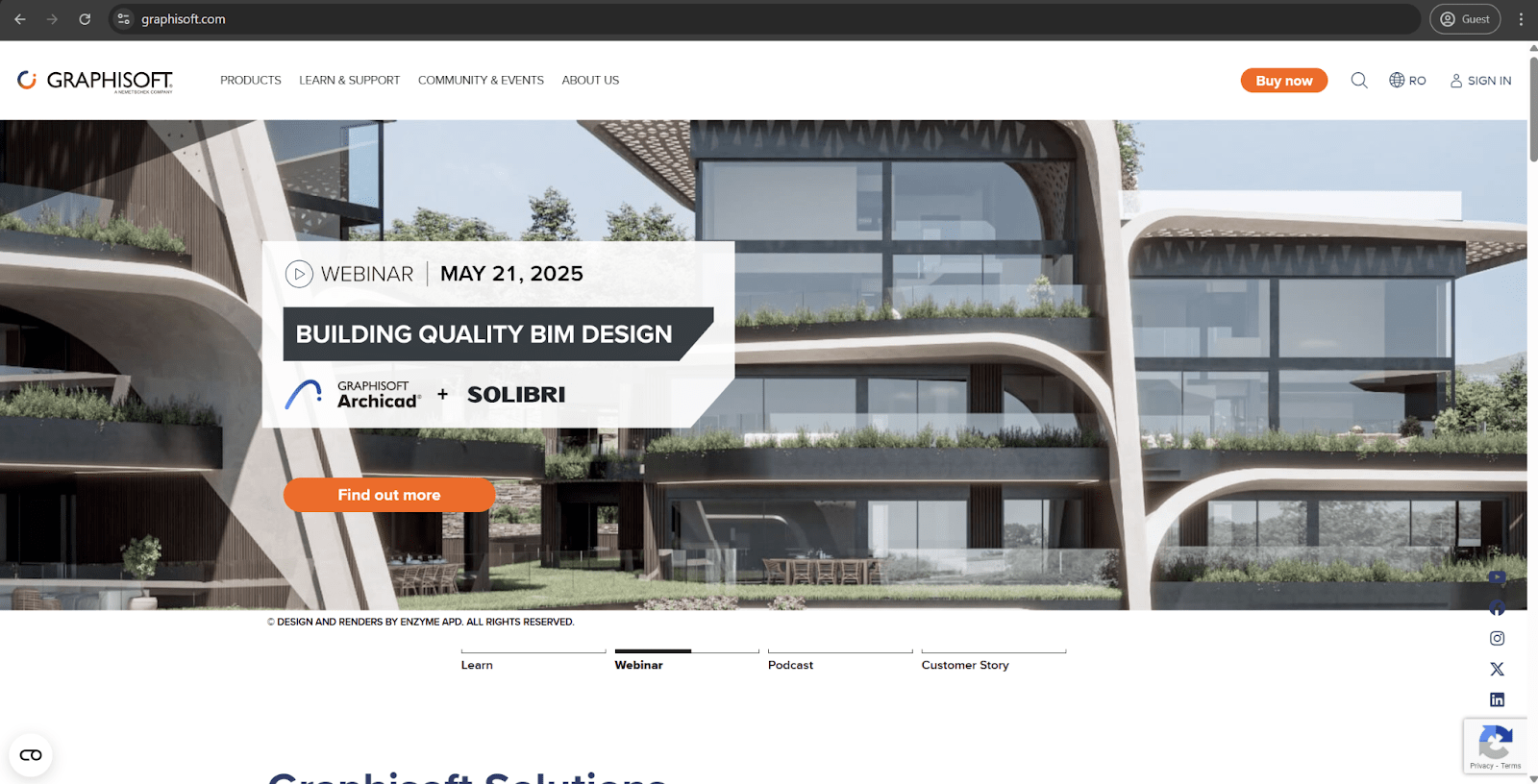
Graphisoft was founded in 1982 in Hungary and has earned its place in BIM history as the creator of the first commercially available BIM software. It is now a part of the Nemetschek Group, continuing to be a substantial player in the global BIM market with its flagship product, ArchiCAD.
ArchiCAD uses an architecture-centric approach and maintains a loyal user base all over the world (particularly in Europe). One of its key differentiators is native support for the macOS and Windows platforms, making it a common option for Apple users in the AEC industry. ArchiCAD also pioneered many concepts that are now considered standard for BIM, such as parametric objects and the virtual building approach.
The software excels in its visualization capabilities, providing intuitive design tools with support for BIM workflows. Recent versions have also had strengthened collaborative capabilities using BIMcloud, a real-time teamwork solution regardless of project size or team location.
Graphisoft’s commitment to openBIM standards is obvious through its strong support for the Industry Foundation Classes standard, facilitating interoperability with other BIM platforms. The company’s mobile solution, BIMx, also bridges the gap between construction sites and design studios, helping stakeholders explore BIM models using only mobile devices.
As BIM adoption continues its growth on a global scale, Graphisoft maintains its position as a leader in architectural design technology, constantly enhancing its software to meet ever-evolving industry demands without straying too far away from its design-focused roots.
Revizto

Revizto has emerged as a specialized but increasingly important player in the BIM ecosystem with a strong focus on model coordination and issue tracking. Founded back in 2012, the company positioned its platform as a collaboration hub, connecting various BIM creation tools in the same place.
Unlike traditional BIM creation solutions, Revizto operates as an integrated collaboration platform capable of converting complex BIM and CAD models into walkthrough-ready 3D environments. This particular approach helps project stakeholders from different disciplines to collaborate effectively without the prerequisite of substantial experience with specific BIM software.
The platform excels in issue tracking and management, assisting teams with identifying, assigning, and resolving various design conflicts. Its real-time synchronization ensures that all team members have access to the most recent project information, which reduces coordination errors and practically eliminates miscommunication.
Revizto supports imports from many different BIM platforms, including Revit, ArchiCAD, Navisworks, Tekla, and many others. The software’s intuitive interface and minimal learning curve have contributed greatly to its rapid adoption among architecture, engineering, and construction firms all over the world.
With the increased demand for collaborative BIM workflows, Revizto’s positions have strengthened drastically over the years, integrating virtual and augmented reality capabilities to enable immersive model exploration for stakeholders, and it is a great solution for client presentations and on-site construction coordination for precisely this reason.
As project complexity and team sizes grow, Revizto retains its focus on streamlined communication with issue resolution capabilities, offering significant value in the BIM workflow without attempting to directly compete with traditional BIM creation software.
Bentley Systems
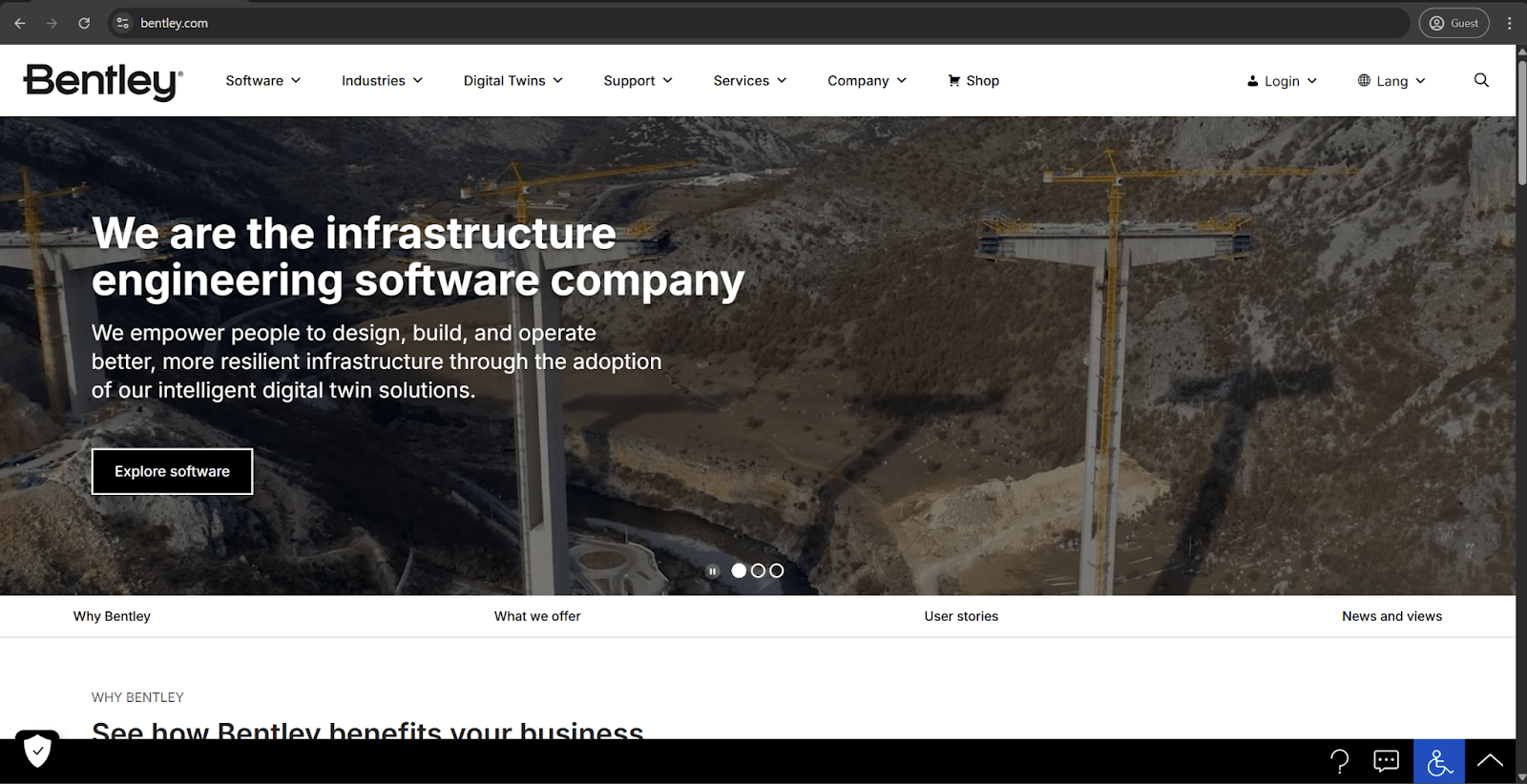
Bentley Systems was established in 1984, building its reputation on developing complex software for infrastructure projects. This is also the company’s primary approach to BIM, with most of its efforts centered on infrastructure lifecycle management, covering the design, construction, and operation phases of each project.
Bentley’s flagship BIM platform is MicroStation, which serves as the foundation for many of its domain-specific applications. OpenBuildings Designer is the one we are looking for. It provides comprehensive BIM capabilities for architectural and engineering design processes. The platform is especially powerful when it comes to handling complex and large-scale projects such as industrial facilities, airports, hospitals, etc.
Bentley Systems focuses a lot on civil engineering and infrastructure projects, which is its main distinguishing trait in the BIM field. While many competitors, such as Graphisoft and Autodesk, have traditionally emphasized building design, Bentley has operated differently, developing specialized solutions for railways, utilities, bridges, roads, industrial plants, and so on. This is also the primary reason why Bentley is still the preferred choice for civil engineering projects all over the planet.
The company has been at the forefront of the digital twin technology, as well, enabling real-time analysis and monitoring of physical infrastructure via connected data environments. The ProjectWise collaboration system facilitates distributed work across global teams, managing engineering data throughout the infrastructure lifecycle.
Bentley Systems continues to expand its BIM capabilities with strategic acquisitions and development, strengthening its position in the industry. By integrating geospatial information, engineering data, and operational technology, Bentley pushes boundaries of what BIM can accomplish in infrastructure management.
Nemetschek Group
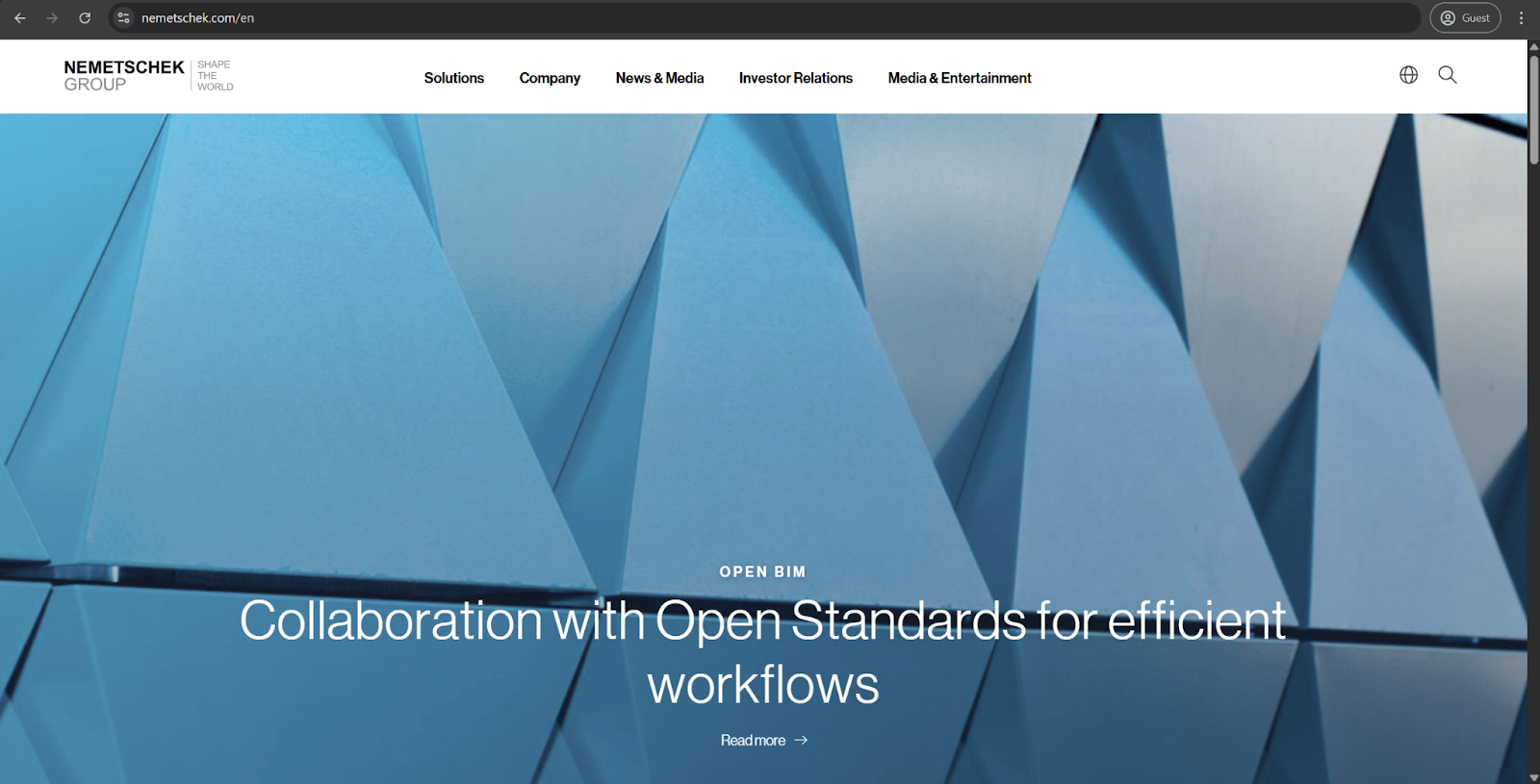
The Nemetschek Group, founded in 1963 by Georg Nemetschek in Munich, is one of the largest providers of AEC software on the modern market. Unlike many of its competitors, Nemetschek operates as a holding company for a number of brands, with each brand serving specific aspects of the building lifecycle.
This multi-brand strategy allows Nemetschek to address diverse needs across the AEC industry using its specialized solutions. The abovementioned ArchiCAD from Graphisoft is only one example of such software, and the group also offers other solutions such as Allplan, Vectorworks, Solibri, SCIA, and Bluebeam.
One of the defining characteristics of Nemetschek’s approach is its commitment to openBIM standards and interoperability. It has been a vocal advocate for open standards and workflows, supporting the buildingSMART initiative and IFC implementation across its entire product range. Its primary philosophy stems from the belief that customers should have the freedom to choose the best tools for specific tasks without being locked into a single vendor’s ecosystem.
Nemetschek continues to expand its capabilities through strategic acquisitions, strengthening its position across the design, building, and management segments of the construction industry. Its diversified portfolio and openBIM approach offer a compelling alternative to more integrated but less flexible offerings from some of its competitors on the market.
Vectorworks
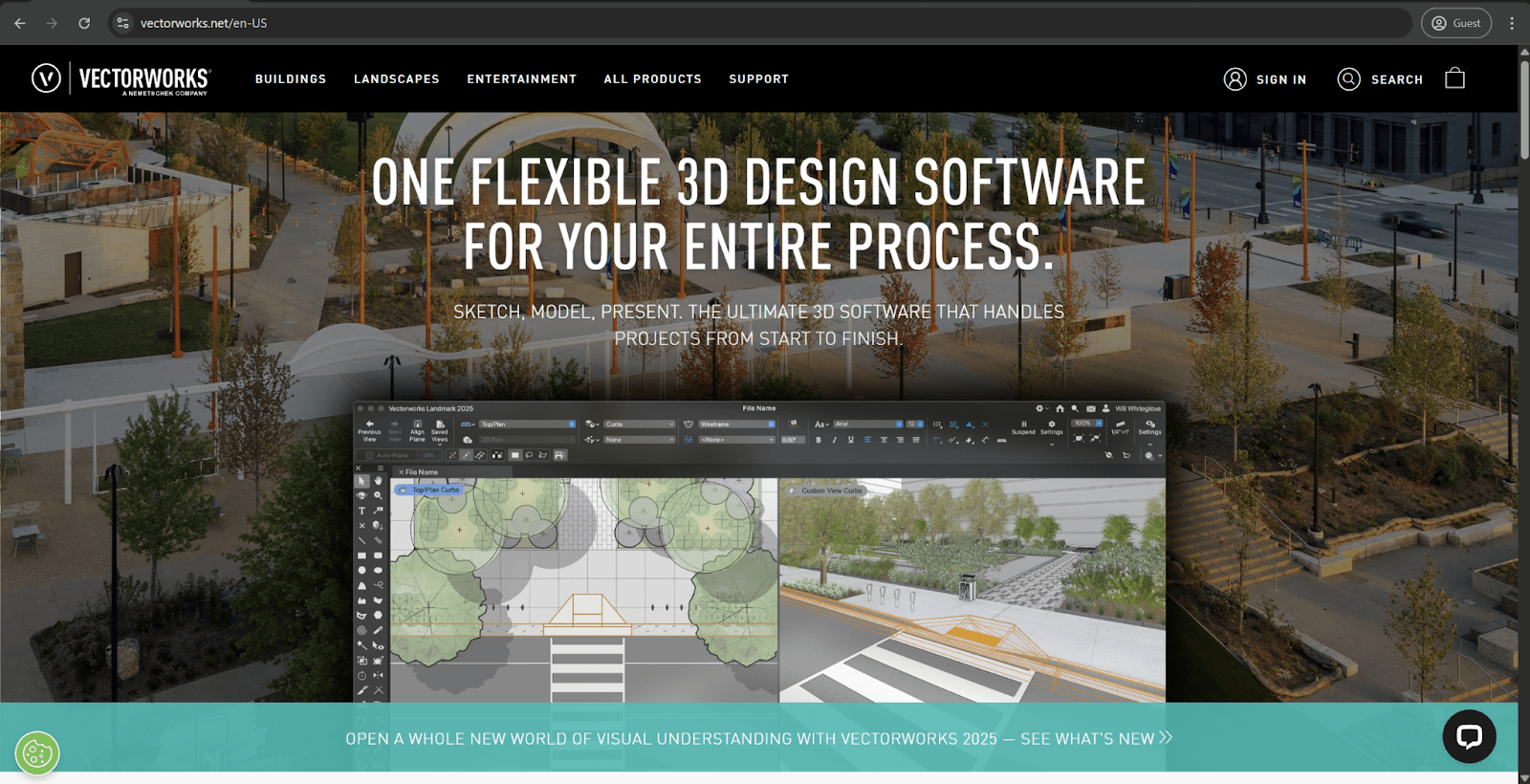
Although it is part of the Nemetschek Group, Vectorworks also deserves individual recognition for its unique position in the BIM landscape. It was originally developed as MiniCAD for Apple computers back in 1985 before evolving into the comprehensive design platform it is known as today, operating in the architecture, landscape architecture, and entertainment industries.
Versatility is what sets Vectorworks apart from most of its competitors: it extends BIM principles to landscape design, urban planning, and entertainment design, such as stage, lighting, and event planning. This cross-disciplinary approach appeals to design-focused practices that operate irrespective of traditional boundaries.
The solution balances a powerful BIM toolset with intuitive design tools, making it more accessible to smaller businesses and even individual practitioners. It reduces the need for multiple specialized applications, offering 3D modeling, 2D drafting, rendering, and BIM capabilities in a single package.
Its heritage as a Mac-native application also continues to appeal to Apple users en masse, with the modern-day Vectorworks solution providing full feature parity with the Windows version. It also has a design-centric interface that reflects its roots in the creative industries, prioritizing user experience and visual quality above all else.
Recent developments have strengthened Vectorworks’ cloud collaboration capabilities, as well as its interoperability with other BIM platforms. The software manages to maintain its position as a distinctive alternative for design professionals who want both creative freedom and BIM functionality by committing to continued development and integration with the broader Nemetschek ecosystem.
Dassault Systèmes
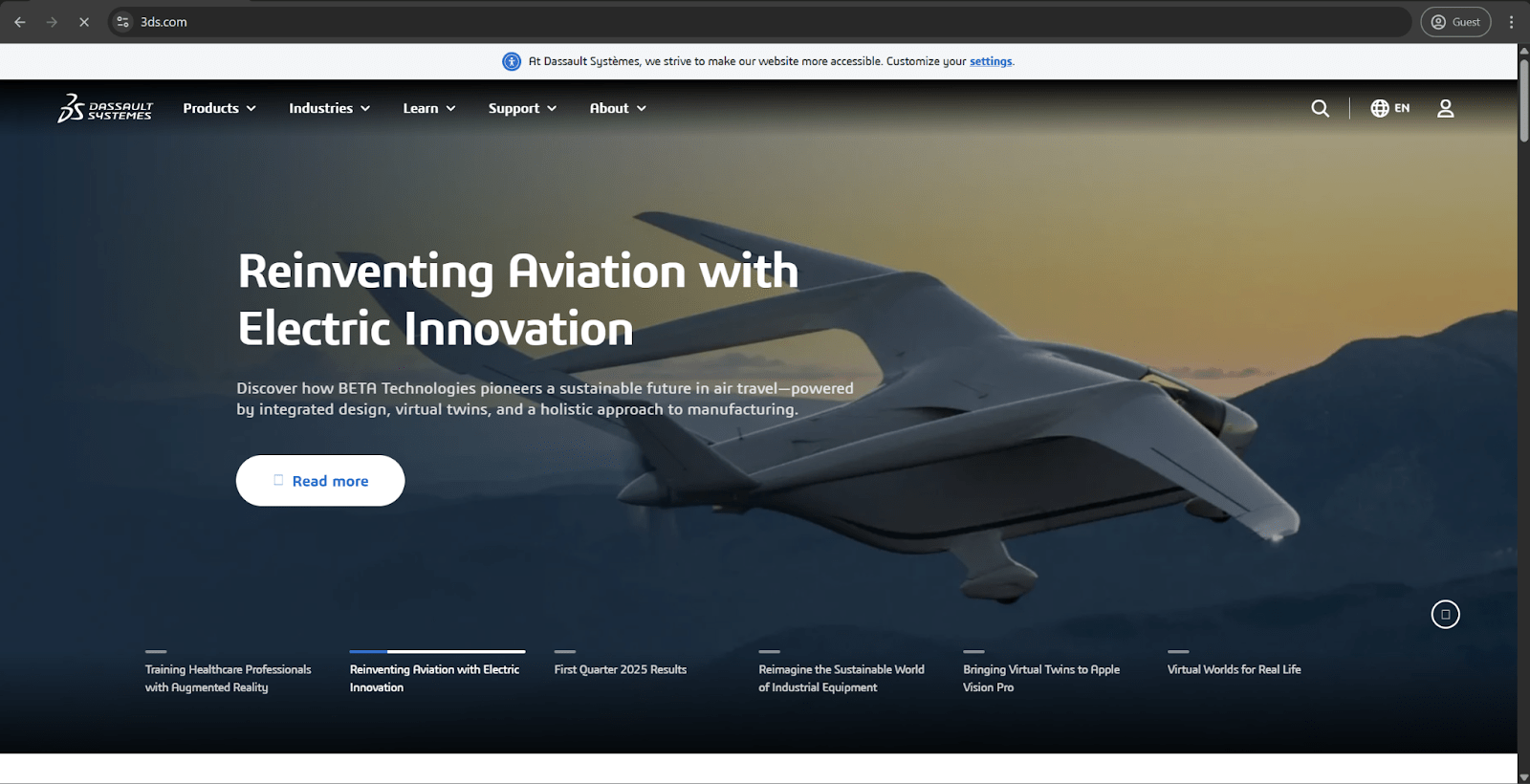
Dassault Systèmes is a French software giant best known for CATIA and SOLIDWORKS, which operate in the manufacturing industry, and it has also made a substantial investment in the AEC field using the 3DEXPERIENCE platform. It can be considered a relative newcomer to building-focused BIM, but its decades of experience in complex product lifecycle management put it in a very special position in regards to the construction industry.
Its general approach differs from traditional BIM vendors, putting a strong emphasis on an integrated platform connecting design, simulation, project management, and collaboration capabilities. Dassault’s vision encompasses the entire built environment as a complex product with lifecycle considerations rather than focusing only on geometry and information.
CATIA is a powerful surface modeling solution that was originally developed as software for aerospace design. It is a particularly valuable solution for challenging projects with high architectural ambitions. Frank Gehry’s architectural practice famously adopted CATIA to work on complex buildings such as the Guggenheim Museum Bilbao.
Dassault’s AEC capabilities integrate engineering analysis and simulation on a deeper level than many competitors offer, making it possible to conduct performance-based optimizations. This is a very special approach that reflects the company’s manufacturing heritage (where simulation-driven design is a standard practice).
The 3DEXPERIENCE platform, on the other hand, emphasizes collaborative workflows and data continuity across disciplines, supporting the increasing convergence of construction, design, and operations. Cloud-based access to the platform also enables distributed teams to operate together on complex projects regardless of their own locations.
Dassault Systèmes has yet to achieve the degree of market popularity that most of its prominent competitors have, but it already has a unique position on the BIM market due to its specialized capabilities for complex geometry and simulation in the architecture and infrastructure fields.
Autodesk
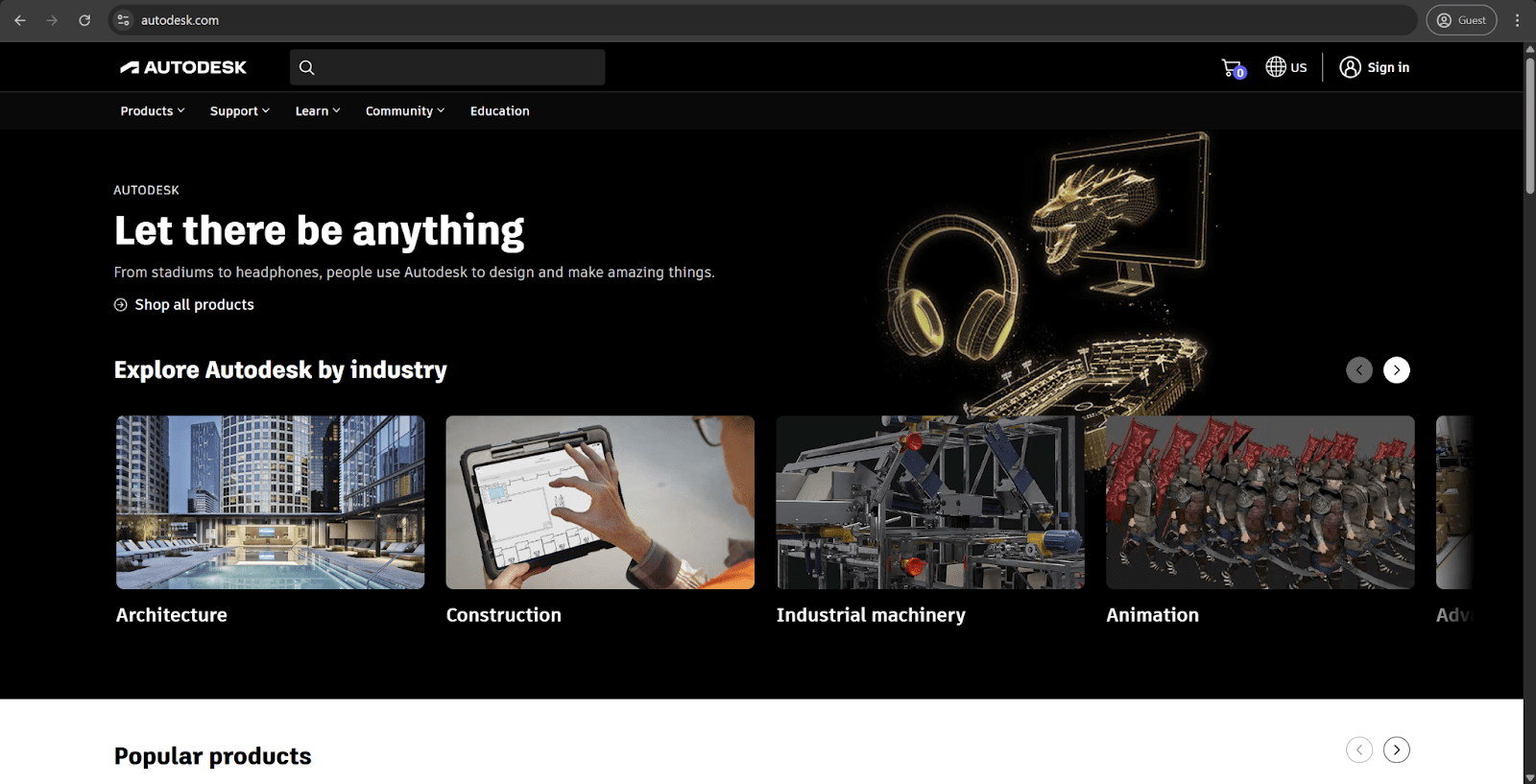
Autodesk is a well-known software provider in several different fields, with Revit being widely known as the most popular BIM platform in the world. Developed originally by Revit Technology Corporation and acquired by Autodesk in 2002, Revit has already become synonymous with BIM for many industry participants.
One of the biggest advantages of Revit is its integrated approach to building information modeling, with a centralized database driving all model views and documentation, while many of its competitors evolved from traditional CAD systems at some point in time. Revit’s parametric database approach ensures that changes that are made anywhere in the model can be propagated throughout all drawings and schedules, keeping the entire project model consistent at all times.
Revit’s comprehensive feature set can address the architectural, structural, and MEP disciplines using the same software environment. It facilitates coordination between specialties and supports integrated project delivery methods, combining flexibility and standardization in the same BIM offering.
Revit’s current position on the market has also formed a vast ecosystem of add-ons, libraries, resources, and skilled users around it. Integration with other Autodesk products offers a cohesive workflow throughout the design and construction processes, while the use of Autodesk Construction Cloud extends the solution’s original cloud collaboration feature set.
Revit continues to evolve to this day, enhancing its interoperability, computational design tools, cloud-based collaboration features, and more. It can be challenging to get into at first, but the combination of widespread adoption and a comprehensive feature set have established Revit as the de-facto standard for BIM implementation in most markets around the world.
Tekla (by Trimble)
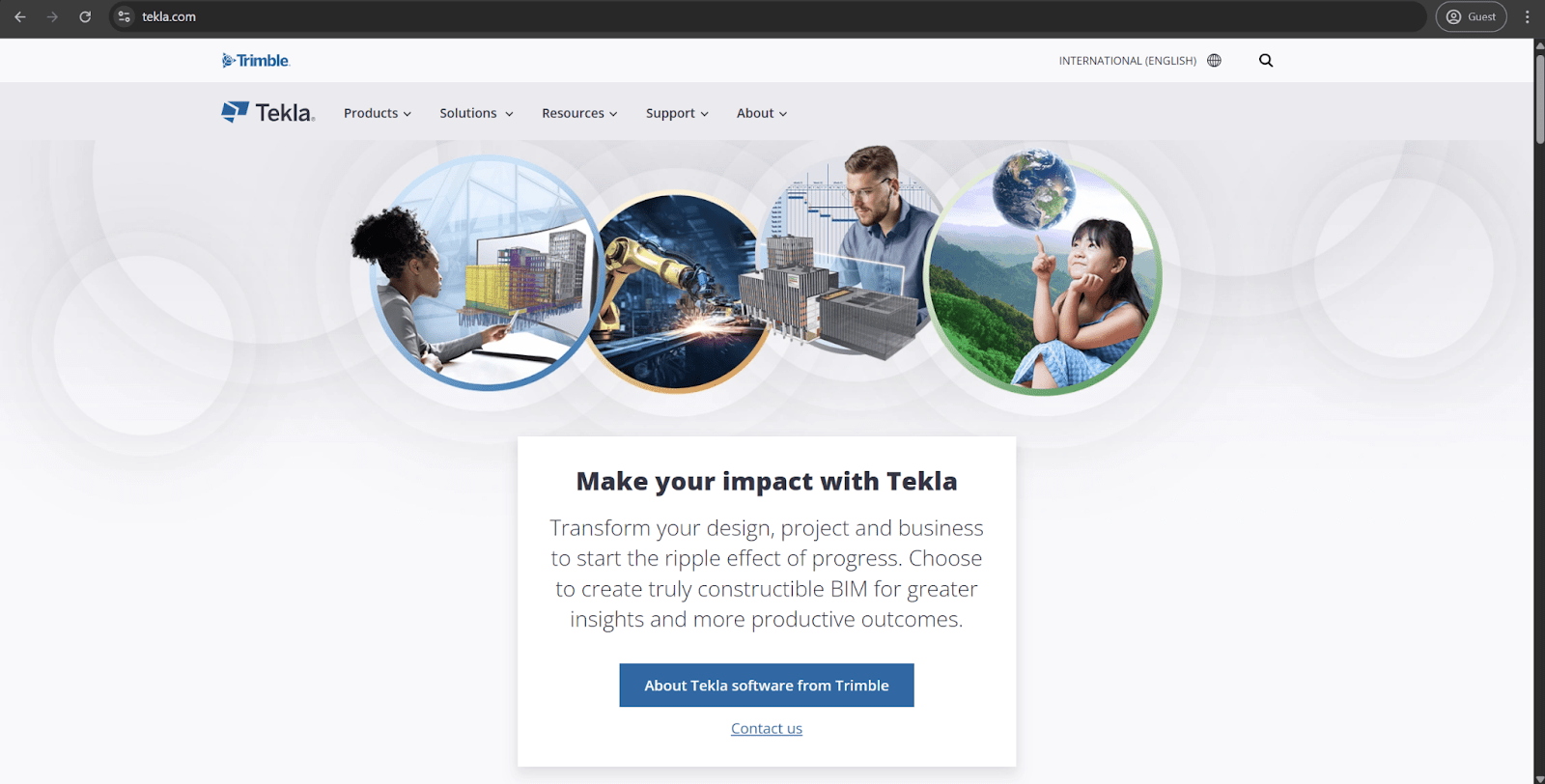
Tekla Structures (part of Trimble’s portfolio since its acquisition in 2011) is another example of a reasonably popular BIM software company with a single primary solution. It originated in Finland as XSteel in the 1990s, pioneering the concept of model-based structural engineering well before BIM became an industry standard.
Detailed structural modeling and documentation distinguish Tekla Structures from its peers. The solution excels at producing highly accurate, constructible models that contain all the fabrication-level information needed to actually build structural elements. This is why Tekla is the preferred solution for many structural engineers, steel fabricators, and concrete contractors worldwide.
The biggest strength of Tekla’s platform is its ability to model complex structural systems using a variety of materials, such as steel, concrete, timber, and so on. It offers comprehensive detailing capabilities for steel construction, and its rebar detailing and precast element modeling remain its primary features for concrete construction.
Tekla Structures operates using an open BIM philosophy, with support for various exchange formats and interoperability with different MEP or architectural systems in the field. The software’s capabilities for integration with Trimble’s existing construction technology ecosystem connect structural design with scanning, field layout, construction management, and more.
Recent developments have also enhanced Tekla’s collaborative capabilities via Trimble Connect, while AI-powered features have been introduced for model optimization and drawing creation. As structural systems become more and more complex, with prefabrication growing more prevalent, Tekla Structures keeps setting the standard for structural BIM implementation across the entire construction industry.
Bricsys (BricsCAD BIM)

Bricsys is another unusual player in the BIM landscape, with BricsCAD BIM offering a noteworthy alternative to many established platforms in the field. The company was founded in Belgium in 2002, building its reputation since then by offering DWG-compatible CAD solutions before attempting to expand into the BIM domain. It was also acquired by Hexagon in 2018, placing the software into a broader ecosystem of construction and geospatial technologies.
BricsCAD BIM is a unified platform that combines CAD and BIM capabilities, allowing users to work seamlessly with traditional 2D drafting and 3D building information modeling in the same environment. It also retains a lot of its CAD capabilities, as well, with full DWG compatibility alongside a comprehensive BIM feature set.
The AI-powered technology BIMify is a substantial advantage for BricsCAD. It automatically converts 3D solids and surfaces into intelligent BIM components when prompted. It is an innovative approach that reduces the manual effort typically required in BIM, and the absence of complex parametric constraints greatly simplifies model editing in 3D. The platform covers not only the architectural, but also the structural and MEP disciplines, with a substantial portion of its popularity coming from smaller businesses that are looking for a more cost-effective BIM solution than Revit or its direct competitors.
BricsCAD embraces open standards and interoperability, with support for the IFC format and multiple data exchange protocols. It can be integrated with other Hexagon products when necessary, such as when reality capture or point cloud processing capabilities are needed, expanding the total range of possible use cases.
Recent developments of BricsCAD have focused a lot of effort on enhancing the machine learning capabilities of the platform, improving its component recognition and classification features while working on providing cloud collaboration via Bricsys 24/7. As the overall BIM market continues to grow and evolve, BricsCAD BIM will remain as an accessible yet powerful BIM solution, with a particular appeal for businesses that want to balance advanced BIM functionality and familiar CAD workflows.
Conclusion
The evolution of building information modeling has fundamentally changed the AEC industry, bridging the massive gap between practical construction realities and complex design aspirations. The distinction between BIM companies and BIM solution providers showcases the complementary nature of technological development and implementation expertise, and both categories are essential to the industry’s digital transformation.
As the AEC industry continues its digital evolution, the role of BIM companies and solution providers will only keep growing. The future promises deeper integration of emerging technologies into existing BIM workflows to create smarter, more responsive built environments. Every single modern-day BIM software provider is laying the groundwork for a more efficient, sustainable, and collaborative construction industry in the future.
Frequently asked questions
What services do BIM companies typically provide?
BIM companies typically provide comprehensive services such as:
- architectural design
- structural engineering
- MEP coordination
- urban planning
- construction management
All these services utilize BIM methodologies throughout the project lifecycle, delivering everything from initial conceptual design and 3D modeling to construction documentation, project coordination, clash detection, and support for facility management.
How do BIM companies support sustainable construction practices?
BIM companies can leverage advanced modeling and simulation capabilities in order to optimize building performance and conduct energy analysis, daylighting studies, and carbon footprint assessments during the design phase to minimize the overall environmental impact. They can use BIM tools to reduce material waste via precise quantity takeoffs, passive design strategies, green building certifications, and data-rich models capable of supporting efficient building operations throughout the entire lifecycle of a structure.
What criteria should be used to select a BIM company for a project?
When attempting to choose a BIM company, it is important to evaluate the company’s:
- Technical expertise in your specific type of project
- Portfolio of similar completed projects
- Complexity of BIM implementation
- Collaborative capabilities with multi-disciplinary teams
Its track record in meeting budget restrictions and project timelines is also important, as are a commitment to sustainability and expertise in emerging technologies such as cloud collaboration and AI-powered optimization.
Are BIM companies focused solely on construction, or do they serve other industries?
While BIM companies do operate primarily in the AEC industry, there are also a lot of examples in which such businesses expand their services to infrastructure projects, such as transportation systems, utilities, and urban planning. There are also plenty of examples of businesses that apply BIM principles to specialized sectors, such as entertainment design, landscape architecture, industrial facilities, and many others, showcasing the versatility of BIM methodologies outside of traditional building construction.
Unlock seamless BIM collaboration — request your demo today


